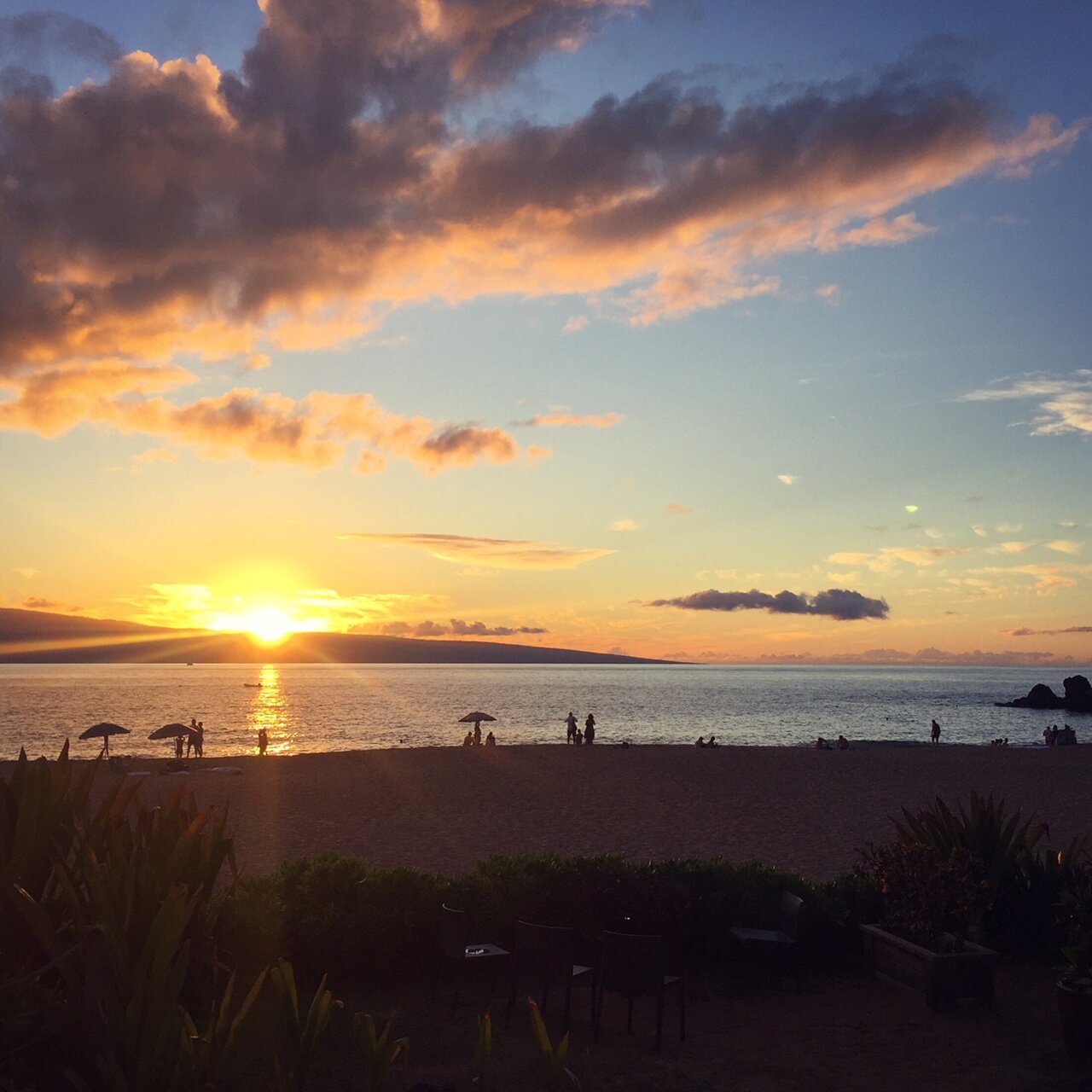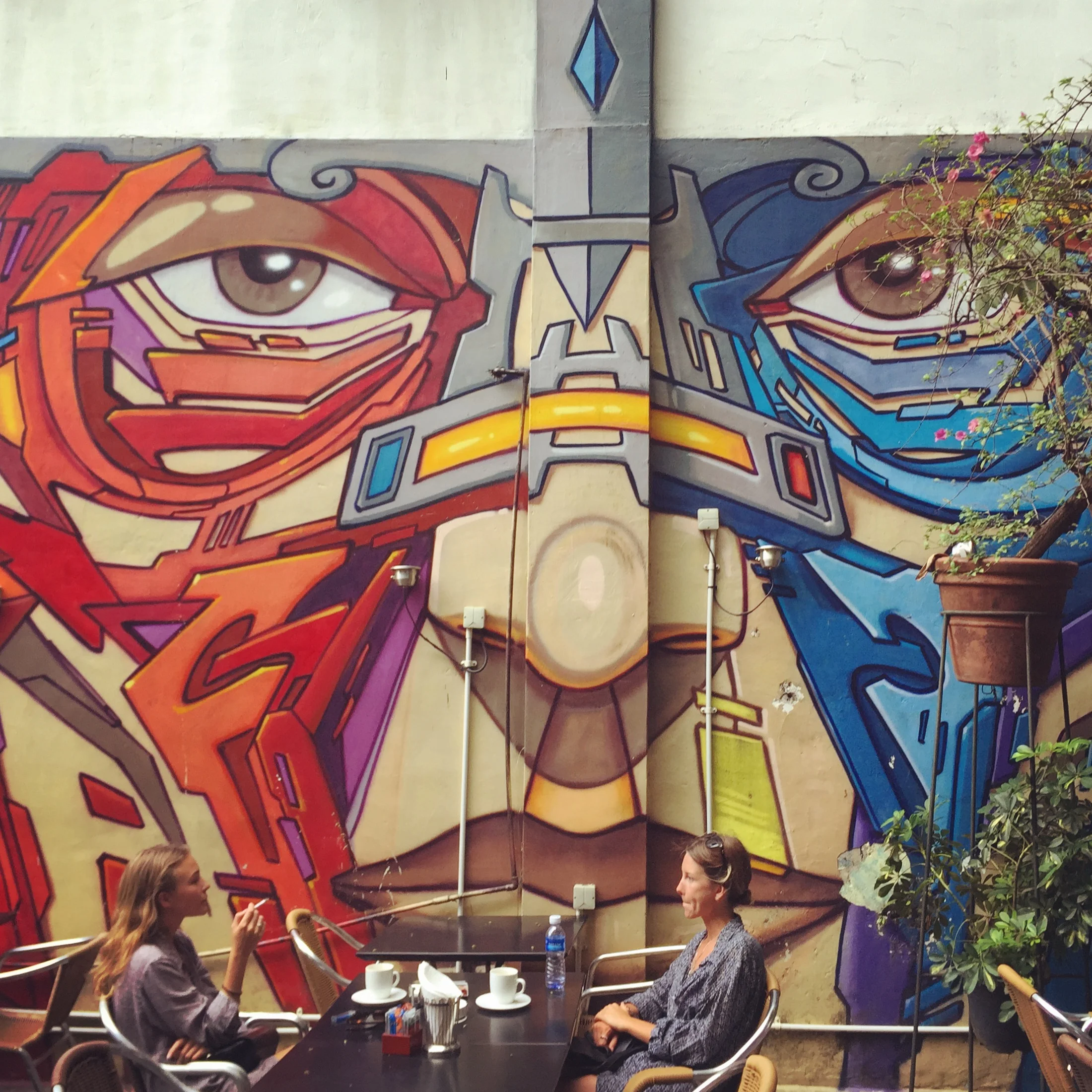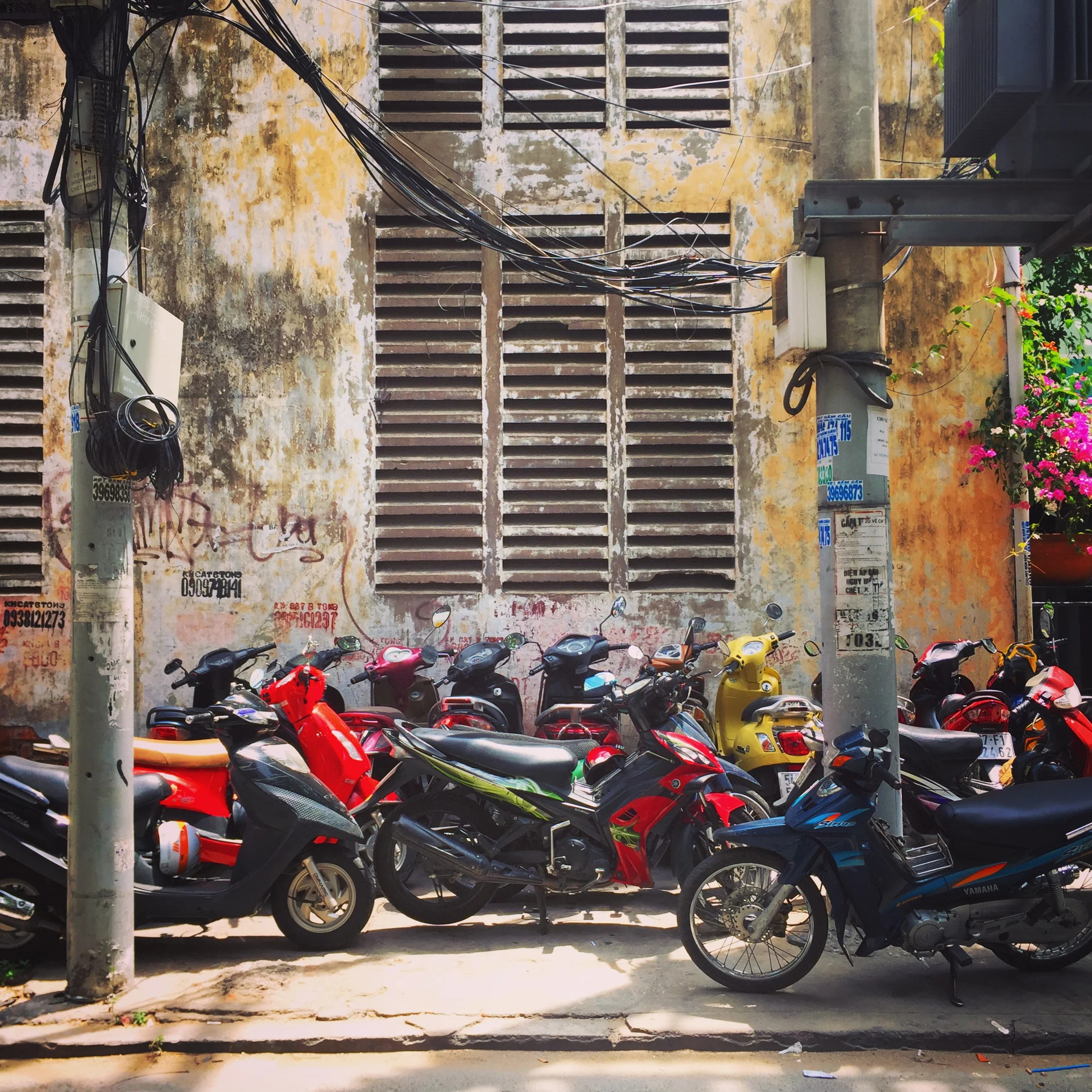As I've touched on before, there's a certain level of masochism inherent to travel. Sometimes the payoff isn't quite worth the suffering (like a minivan driver with a death wish) but other times, even hobbling along with rocks jabbing the soles of your feet, face down against the perpetual onslaught of drizzle, the pain is worth the gain.
When I did my trek in Sapa, I was blessed with gorgeous weather. The violent thunderstorms that passed over during the night gave way to sunny skies that lit up the rice paddies and warm sun that dried the wet paths. When I read in my Lonely Planet that most people skip the trekking routes during monsoon season, I thought I'd just get to Kalaw and suss out the scene. No one at the trekking office seemed particularly concerned about any upcoming rain, and all things considered, other than being unpleasant it wasn't totally unmanageable. What made it unmanageable was my lack of preparation, namely lack of appropriate footwear.
My lightweight New Balance sneakers were fine for Sapa's trek, although my heel started hurting on day two, probably due to lack of adequate arch support. But with a walking stick and taking the steep parts of the trail slowly, I did fine.
On the trek between Kalaw and Inle Lake, however, it became apparent a few hours into setting off on day one that my almost tread-less shoes were not going to cut it in the slick, wet mud. Our guide, July, mentioned that I could get new shoes at the train station village we'd get to in the afternoon and I spent much of the first day dreaming of what kind of shoes they'd have available. It turns out they were the same pair of shoes our guide July wore, which might be all that's really available in Myanmar. Made of green canvas, they reached just to my ankle and came with a thick, heavy rubber sole perfect for gripping into the mud. The good news was they were a mere 3,500 kyat (less than $3.50). The bad news was the train station village shop didn't have my size.
So the choice was: do I continue on in shoes that can't handle the conditions, or wear a size too big, handling the mud but uncomfortable otherwise to walk in, knowing that with shoes sliding around on my feet, getting wetter and wetter with every step, they'd bring on an inevitable crop of blisters?
I went with the second choice; better to risk blisters and foot pain than fall down and actually injure myself. I was able to handle the terrain far better, but the shoes, lacking any kind of insole, shock absorption or arch support, meant that every step we took on a firm road sent waves of pain through my feet. By the end of day one, my left heel and top of my right foot ached; by the end of the day two, rings of blisters had formed around my big toes; by the middle of day three I left the too-big shoes behind at the restaurant where we had lunch before walking to our boat that would take us across Inle Lake.
But, as I said, the pain was worth it. Unlike Sapa where certain stretches of the trek meant negotiating the trail along with numerous other trekking groups, plus fending off the fairly aggressive tribal women wanting to sell jewelry and embroidery, the terrain we covered was almost entirely empty, save for rolling fields of rice and vegetables where we'd pass locals at work. Other than another large trekking group and a few couples, we saw virtually no other Westerners. We passed through occasional villages, stopping in the morning and afternoon for a tea break. Our first lunch was perched high atop a mountain in a field where Mandarin oranges and tea is grown; July explained that historically the region grew opium but to open the region to visitors, the government had fought the hill tribes to cease production of the cash crop. (It seems safe to assume that many of the off-limit parts of Myanmar are because there is either fighting between ethnic minorities and the government, or because there is still opium being grown, or both.)
We continued that afternoon along narrow muddy paths sheltered by forests, ox-cart roads filled with rocks and water, and finally made our way down train tracks for a solid hour before reaching the train station village where my new shoes were bought. Our guide reassured us that the train moved so slowly we'd be able to hop off the tracks if any was heading our way; along the way we came across many schoolchildren heading home in their green-and-white uniforms.
At the train station village, the guys in our group tried chewing betelnut (very popular in Myanmar) and we got out of the rain for a bit and drank tea while watching all the children play outside. This is true around much of SE Asia from what I've witnessed; because family and village community life are so tightly knit and safe, parents are still able to let their kids run free. We watched as a young boy (about 5) and slightly older girl (about 7 or 8) played pretty rough, hitting and tackling each other while squealing in joy and laughter at their 'fight'; no adult swooped in to reprimand the kids or tell everyone to be nice. It's refreshing to watch kids have the freedom to be kids; maybe there is something kind of repressive about our Western/American society constantly policing children and suppressing their kid-like tendencies to duke things that creates other issues that manifest themselves later on? The attitude here is that the adults seem to have an eye out for things going actually wrong, but otherwise kids are pretty much left alone to play and explore without a lot of intervention.
After our tea break, we sludged along for a few more hours to our first homestay, a bamboo dwelling on stilts. The first floor housed the water buffalo, and we slept in a room directly above on mats on the floor, listening to the water buffalo shift and groan down below throughout the night. The only thing truly tough about the homestay was that the constant rain had turned the surrounding area into a mudbath, so that getting to the two outhouses meant risking your life going down a steep muddy hill, nearly impossible in plastic sandals (which you definitely wanted for the floor of the outhouse!). We ate a feast of delicious Myanmar food, then July came and sat with us while we peppered her with questions about Myanmar. (Earlier in the day, somone in the day made the mistake of referring to the country as Burma, and we got a good 20 minute lecture letting us know that the country has always been called 'Myanma' by the people and it was the British who, upon meeting the 'bama' people of the middle region referred to the country as Burma. As the Burmese ('bamaese') people constitute only one of the ethnic groups that make up the country, our guide -- who was of a different tribe in the Shan State -- let us know that using Myanmar was the more inclusive, preferred name of the people.)
The next day we set off in rain heavier than the day before. I'd passed up the opportunity to buy a poncho at the train station village and as my North Face rain jacket became thoroughly soaked, I began to regret my decision. Within an hour of walking, I was completely drenched. And as the edges of the shoes were too wide around my ankles, I had rocks in my socks puncturing my feet with every step. I was miserable and beginning to call into question why I was doing this trek. Why didn't the trekking office try to dissuade me? Why didn't they warn us about the rain? I silently whined to myself as we trudged along that morning, up steep narrow slippery shortcuts and along long winding ox-cart paths taking us through valleys growing crops and rice, where locals, clad in bright blue tarps to shield off the rain, worked water buffalo dragging wooden ploughs to till the fields for rice. "Minglabar!" we called out as we passed locals, their faces lighting up with enormous, joyful smiles. "Minglabar!" they'd call back.
We stopped in one village for tea at a friend of July's house. They had a fire burning upstairs but it meant we all had to take off our shoes and socks, which we rung out to dry while we sat cross-legged around the fire sipping tea while July told us about the tribe. Then we all grudgingly had to put back on our wet socks and tie up our wet shoes caked with mud before trekking back out in the rain.
Head bent down against the cold rain, I spent much of the day dreaming of my cozy, warm apartment in San Francisco; I imagined looking out at the blue, glittering Bay from my kitchen window while I'd take a batch of chocolate chip cookies out of the oven or stir a stew simmering on the stove. I began to think of what I'd make when I'd get home. A chicken stuffed with lemon and onion and glazed with fresh herbs and butter, roasted in the oven. Enchiladas with homemade enchilada sauce. Blueberry bars, topped with streusel. A meat pie. Moussaka.
We stopped for lunch at a village where July cooked us a meal of noodle soup with cabbage. Here, I was also able to buy a baby blue poncho which could actually protect me and my bag from the rain. From there it was back to trails for the afternoon and slow going for me as I felt like I was carrying about a road's worth of gravel in my shoes and a pig sty's worth of mud on the outside of my shoes. We continued down a road through fields for an hour or so, then up another trail. The sky finally began to clear a little and while there was no sun, relief from the rain was a welcome change as we all took off our ponchos (great for the rain, not so great for ventilation).
We hiked up a trail on a hill for a long time, finally coming out into a clearing where the landscape had shifted to more dramatic mountains with limestone cliffs jutting up in random places. July stopped at a certain plant on the edge of a field. She plucked a leaf from the plant and broke the stem, which she lifted to her lips and blew into, a stream of bubbles floating out from the stem and into the sky. We all ooh'd and aah'd in delight blowing plant bubbles.
That was the last happy moment of the afternoon until reaching the homestay because the rest of the trek was misery. It was all uphill from there, along a road consisting of deep mud. Every step added about a pound of mud to each shoe, meaning you had to stop periodically to scrape the mud from your shoes. And with my old pair of shoes and my ineffective North Face rain jacket in my bag, my bag now weighed a ton. I lumbered along, trying to appreciate the incredible beauty of the mountains rising up all around us, of the happy faces of the people working the fields greeting us along the way, or just appreciating that the group of people I was trekking with had all turned out to be amazingly nice, funny, fun people, which had the saving grace of making the tough conditions a lot more bearable. Mostly I just thought about being in my kitchen: I'd find a recipe for strawberry shortcake. I'd bake an apple pie. I'll learn how to make carrot cake.
For a while trudging up this hill for the last hour, I was not sure I would make it. I wondered how bad it would look if I asked to be carried up the hill on the back of a water buffalo. I wondered how much respect I'd lose if I asked to be carried on the back of a water buffalo. Maybe we could all revolt together and could have a trekking mutiny and demand to all be carried together on a water buffalo. Thankfully, by the time I started wondering how to rally my trekking comrades into a revolt, we'd made it to the homestay. Also thankfully, this one had its outhouse located on a normal, flat gravel path, meaning I could go to the bathroom without worrying about killing myself.
We ate another amazing dinner and were asleep by 9 p.m. The next day we headed out in the rain for another six hours of walking. We stopped for a tea break just as we got to the edge of the Inle Lake zone and finally the rain seemed to let up and we were treated to patches of blue sky and trails that could actually begin to dry.
There's always that moment in a long, hard hike where you begin to wonder if the end is ever in sight. You begin to think you'll just keep walking forever and ever, off into the sunset, around the globe, until your feet eventually shrivel and your body collapses to the ground. But -- and you always have to remember this -- there is always an end. And in our case, it was at the restaurant where we stopped for our final lunch together where we all tore our shoes off in joy and switched to flip flops and celebrated with beers.
We walked (well, I hobbled) about fifteen minutes to a jetty on the southwest site of Inle Lake and boarded a boat to take us up to the northeast village of Nyuang Shwe. Our small boat motored down a narrow canal flanked by reeds and then out into the broader waters where houses rose up form the marshes on stilts and we saw fishermen perched on the edge of their boats, net in both hands, one foot on the oar. And somehow, the vision of us all together in the boat, facing opposite each other --haggard, tired, dirty, pained -- cruising across Inle with the mountains rising up all around the lake into the mist, made my heart warm and I smiled. We had done it, rocks, mud, falls, leeches and all.
My journey didn't end there. It turned out my hotel was quite a long walk from the jetty in Nyuang Shwe -- well, a long walk when your feet are so sore and blistered that every step an act of abuse. I dragged myself down a long street, worried that I had misunderstood July's map, not sure how much longer I would have to continue enduring the pain before it would finally relent. I showed up at the hotel almost in tears. But then, finally -- finally! -- it was really, truly over. I collapsed on the bed and sobbed for a minute, then took off all my dirty clothes and showered for what seemed like an eternity.
One of the things I've learned about myself on this four-month travelling excursion is that I really like to push myself when I travel. I love the challenge that comes with venturing to places like Myanmar, Cambodia and India, or camping in the middle of Kyrgyzstan, or trying to teach myself how to ride a motorbike, even if while in the middle of the experience I find myself silently whinging about the suffering (or terrified, as in the case of my motorbike escapades).
When I scrolled through the photos of the trek post-shower in Nyuang Shwe, I realized how totally amazing the whole experience really was. We slept in a room above water buffalo! We plucked off leeches! We drank tea around a fire with a local minority tribe! The whole experience suddenly seemed too surreal to be true. But it was. And I had done it. And I would do it again. I would just bring way better shoes.



